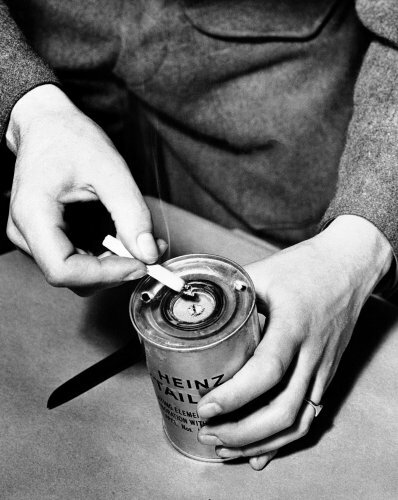Tuesday Triage #75
- TUESDAY TRIAGE #75 by Vadim Drobinin
- On copying
- Things I enjoyed reading
- 1. Against Translation by Benjamin Moser
- 2. What Children Lose When Their Brains Develop Too Fast by Alison Gopnik
- 3. Tea but not by Josh Evans
- 4. My Parents Collect Cans for a Living by Jessica Yauri
- 5. Why did Soviet citizens buy things for a lifetime? by N. Zheludovich
- 6. ‘You immediately tell your friends to cancel their tickets’ – what’s it like to star in a flop? by Mark Lawson
- 7. How to Develop Black & White Film at Home With Coffee by Andrew Shepherd
- 8. The longest train journey in the world – in 2021 by @jonworth
- 9. Could a witcher-style multiverse really exist? We asked a physicist by Maddie Stone
- 10. Faking A Positive COVID Test by Ken Gannon
- Things I didn't know last Tuesday
- 1. Baby, It's Cold Outside origins
- 2. OLY
- 3. Mont Blanc (dessert)
- 4. Live 'blackbird pie'
- 5. Disneyland Long Hair Prohibition
- 6. How to add a background to Safari in iOS 15
- 7. Assassin’s Teapot
- 8. Soft-shell crab
- 9. Artificial banana flavoring
- 10. Self-heating cans of soup
- Book of the week
- Thank you and see you in a week!
TUESDAY TRIAGE #75
by Vadim Drobinin ¶
Your weekly crème de la crème of the Internet is here!
21.12.2021 (read in browser)
-
Intro
Whatever is on my mind this week. -
Things I enjoyed reading
Ten-ish articles I found worth reading. -
Things I didn't know last Tuesday
Ten-ish facts I didn't know when I wrote the previous edition. -
Book of the week
Some thoughts on the latest book I've read.
On copying ¶
The best encounters are the unexpected ones.
This is how I was persuading myself after bying 300 gramms of freshly filleted eel, and learning that they are sold at a ridiculously high price, almost four times more than an aged rib eye steak.
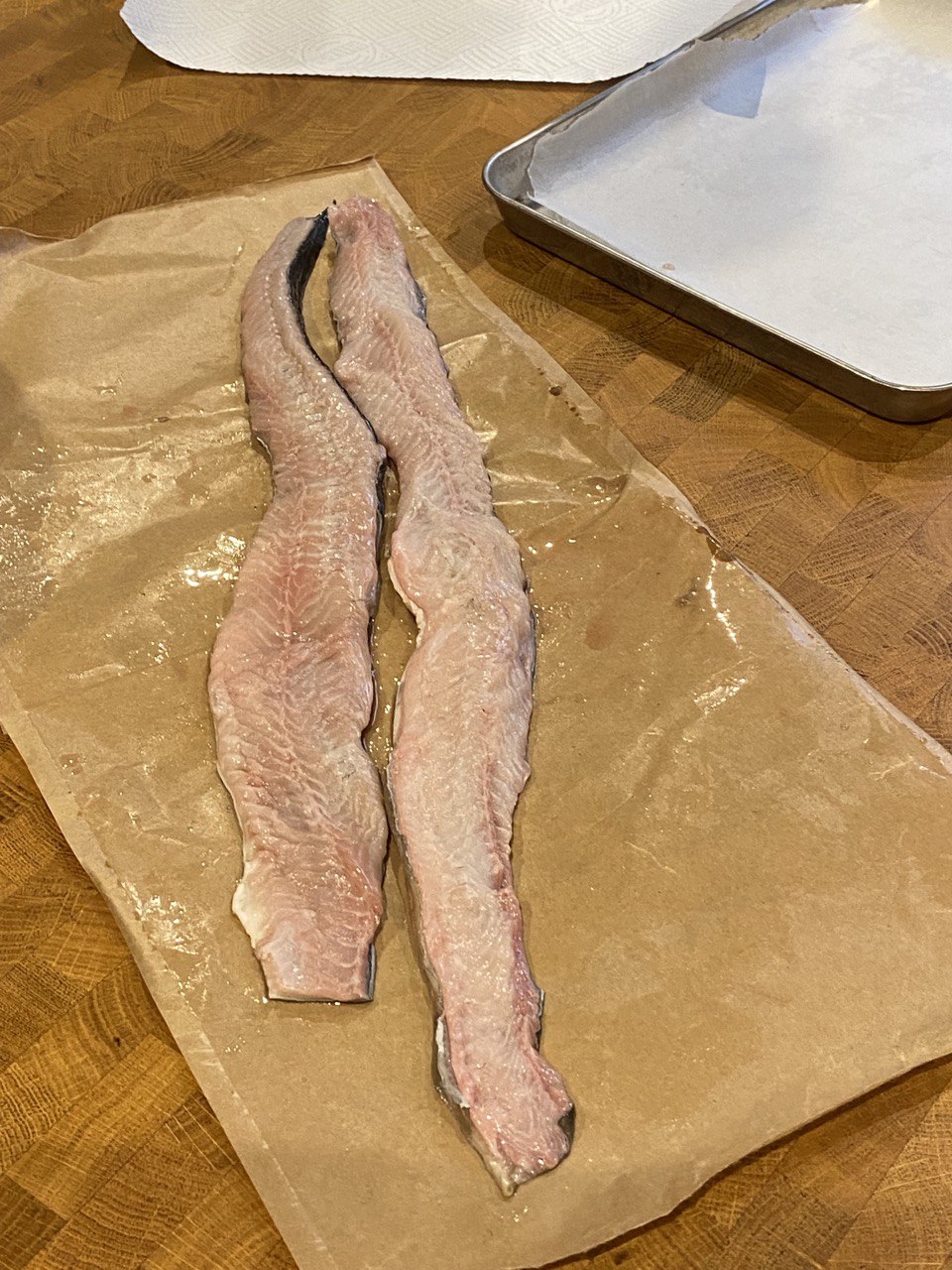
I never cooked eel before, but I ate it either in sushi, or smoked in a sandwich in the Netherlands. The latter would be too cost inefficient given the amount I had, and quick research showed that eels are usually smoked prior to filleting, so I had to replicate the classic Asian flavours instead.
I sliced them into pieces and grilled quickly (five minutes or so):
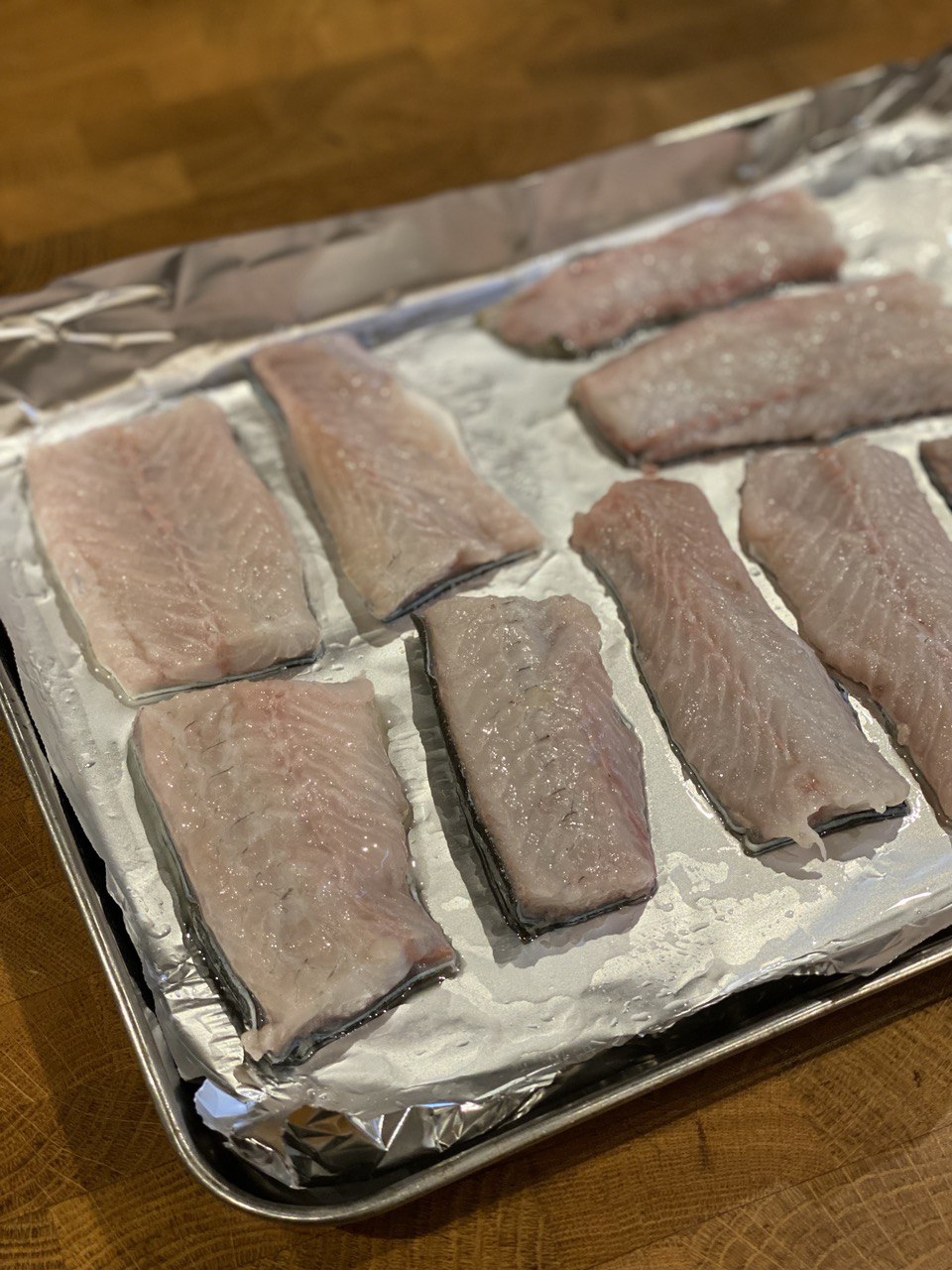
And then glazed with a reduced mixture of mirin, sake, soy sauce, and sugar:
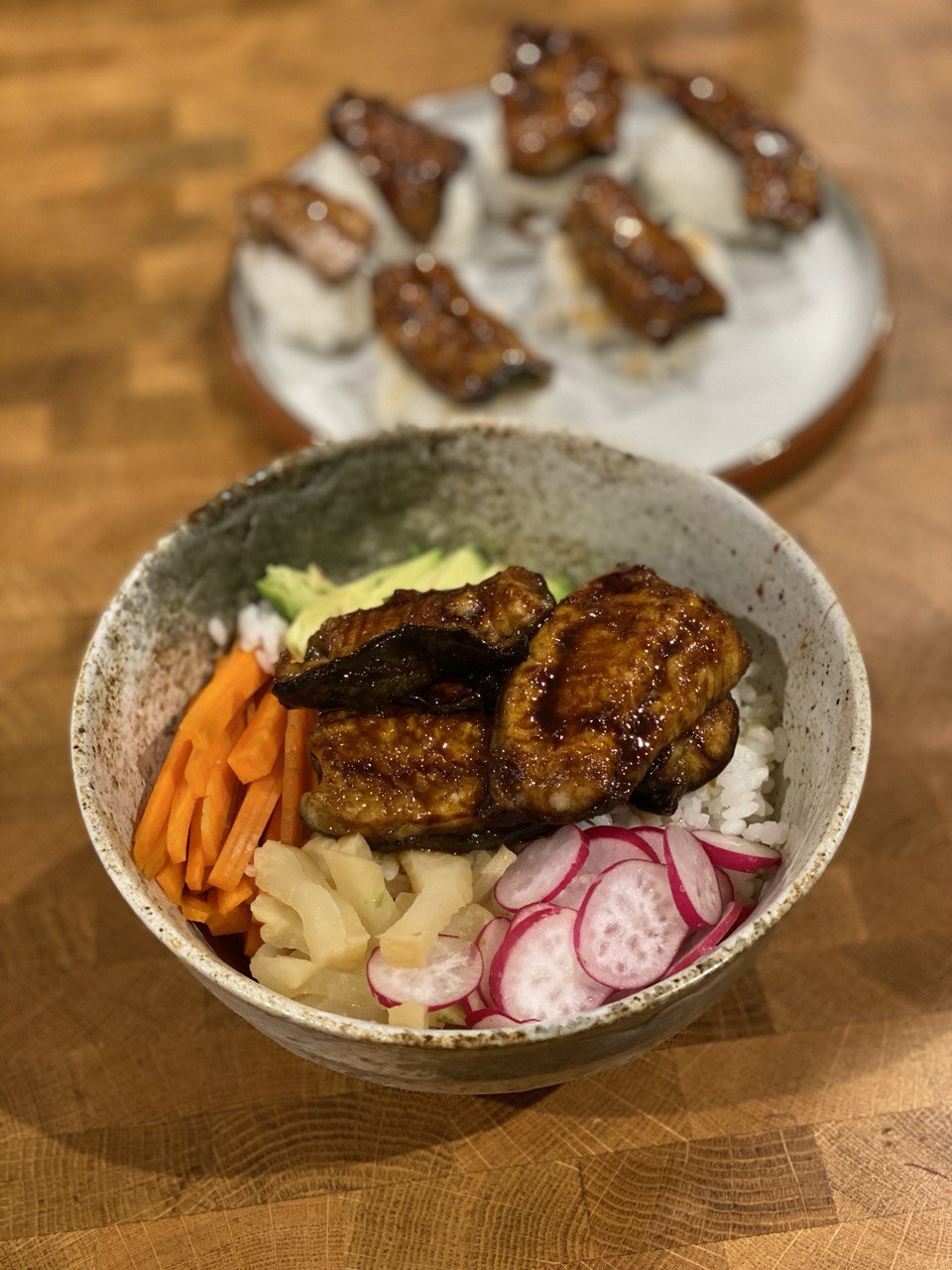
I also got to replicate a dish we've tried during our North trip, made of simply baked parsnips, but instead of just putting them into oven they were coated in spent coffee grounds, akin salt-baking.
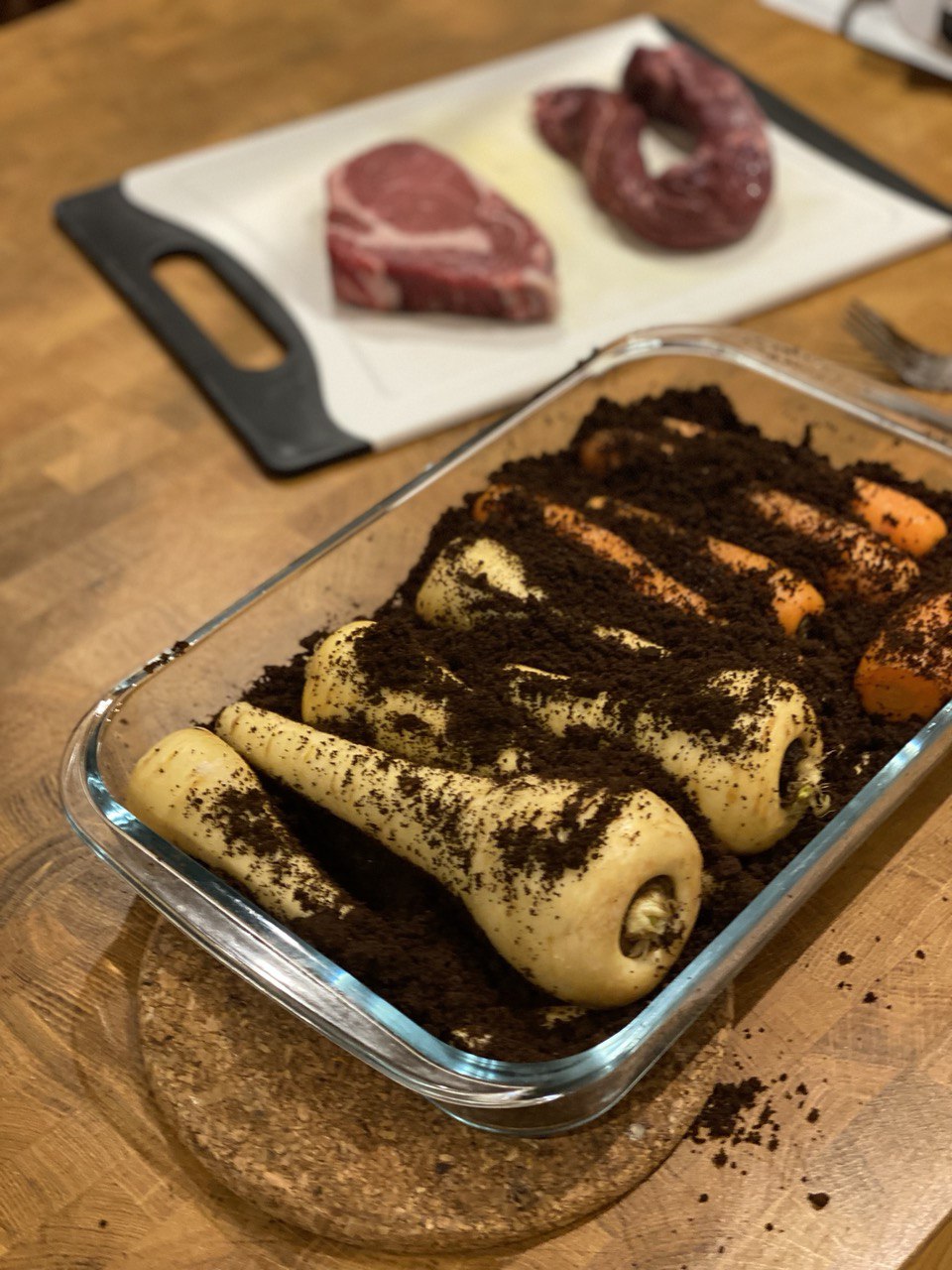
I spent a week gathering those grounds, and the result was really good: served with a rib eye and an onglet steaks. It didn't taste the same though, so next time I will probably change the way grounds are used (maybe mix them with egg white and model around the veggies, who knows).

I also tried to get rid of some of the frozen leftovers (to make room for new frozen leftovers), and found in the freezer a piece of salmon I packed in April. Despite a long time, it looked perfectly fresh (we've vacuum packed and frozen it hours after it was catched), so it went into brine.
This time I tried using beetroot powder to get more control over the colour.
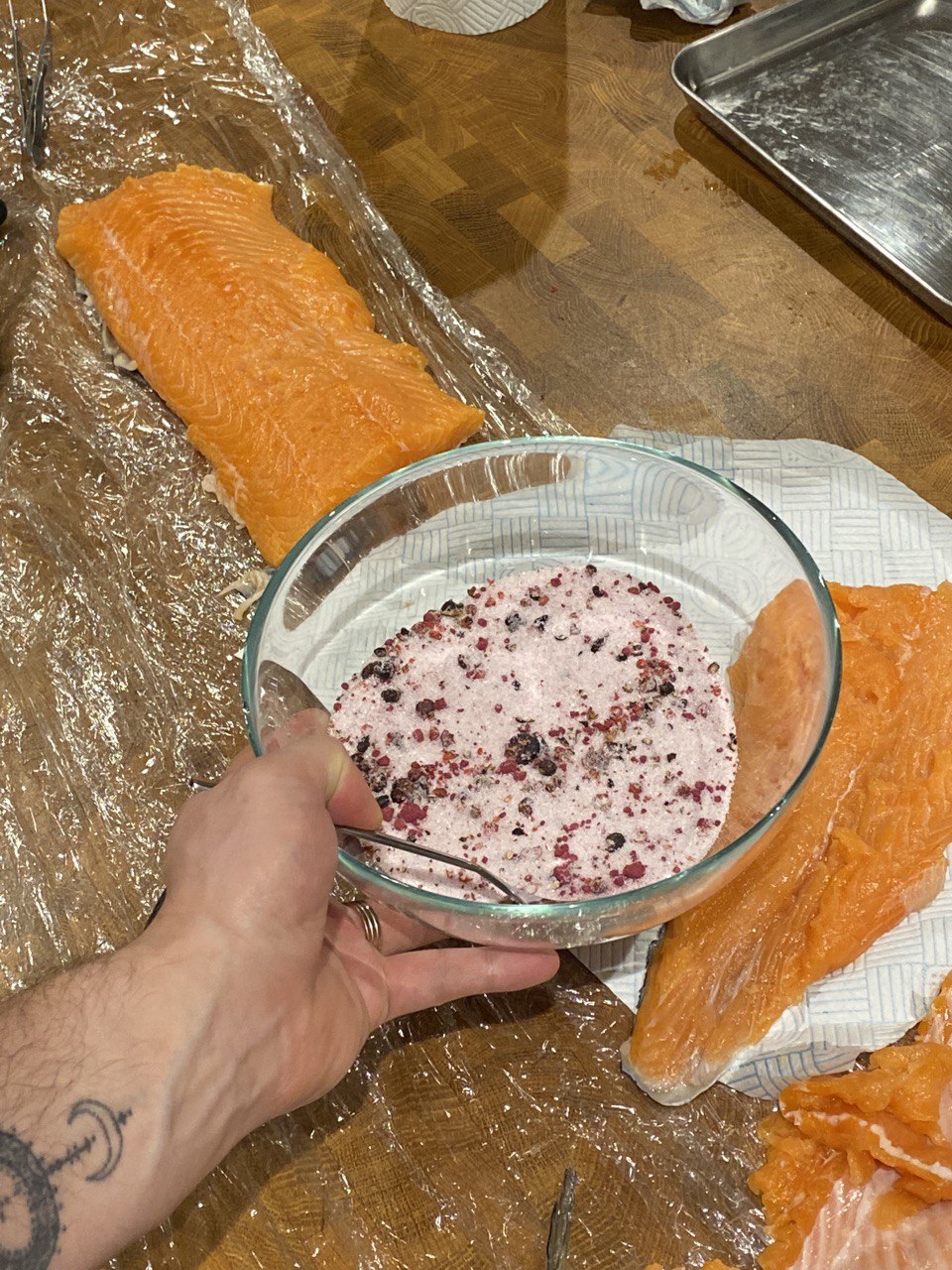
The brine liquid expelled from the fillet a day later was definitely way brighter than usual.
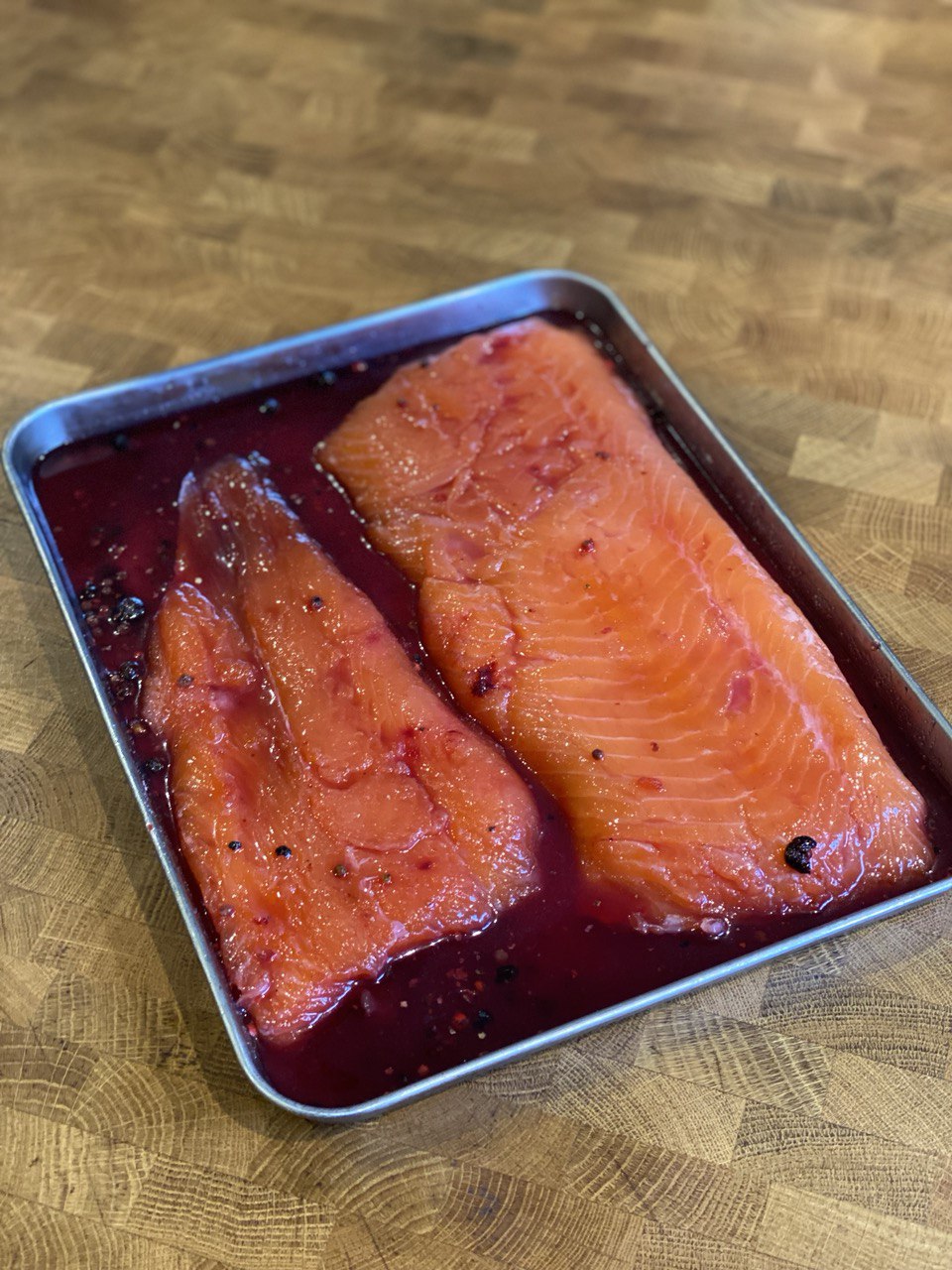
Parts of it went into quick sarnies with a morning glass of Rose:

And the trimmings were glazed in the same fashion as eels:

See, copying others' ideas is not always bad.
Things I enjoyed reading ¶
1. Against Translation by Benjamin Moser ¶
This great essay is mainly focused on difficulties of maintaining a culture in a translation. One perspective is that some translation of a book, a movie, or anything else is way better than the lack of it. However, at the same time by translating things we change a lot, starting from (sometimes) the style or the accents, but going all the way up to making people from non-English speaking countries to focus on getting promoted in New York instead of focusing on their local readers first.
These were the books they had read at school, when they were young, and kept all their lives, even when moving across the ocean. They were too precious to give away — but not valuable enough to sell, not valuable enough for the kids, if there were kids, to keep. Most could be found for a few dollars in online bookstores. It was a miracle that such a collection had survived.
During my first week in the flat, I foreswore friends in order to pick through it. There was something about it that I wanted to understand. As I went along shelf after shelf, I felt an upswelling of emotion, suddenly close to people I thought I had finished mourning years before. Perhaps for the last time, I was a boy spending the night in my grandmother’s house. I wanted to chronicle it, catalog it, before it disappeared forever.
The quote I chose is slightly different. Despite growing up in a completely different country I do understand the feeling of selected bookshelves reminding of one's childhood. My grandparents gather a collection of such books via monthly subscriptions, as that was the only way to source books back then (approved by the Soviet government obviously). The nature of the subscription was to issue mostly full editions, so you'd have all works by Jack London on one shelf, and all works by Chekhov on another.
I still remember the colours of the ones I liked the most (Mark Twain was in red, while Jules Verne was in dark blue).
2. What Children Lose When Their Brains Develop Too Fast by Alison Gopnik ¶
For decades we've aimed at speeding up the way children develop, but this summary of a paper hints at that being a less optimal approach.
Surprisingly, ACEs seem to actually accelerate the pace of physical development. A number of studies suggest that children with stressful lives reach puberty earlier. A new study by Allyson Mackey at the University of Pennsylvania and her colleagues, published in the Proceedings of the National Academy of Sciences, shows that children growing up with more ACEs even get their adult teeth earlier.
In a nutshell, stress causes children to grow up faster, but despite cognitive benefits they lack in empathy and imagination.
3. Tea but not by Josh Evans ¶
Despite being more of a diary than an actual article, this is a great example of food-related research. I can only hope that one day I will have enough persistence to have such a detailed notes on my cooking endeavours.
Justine found fireweed in Charlottenlund on Tuesday 23.7. I stripped the leaves that evening, rolled and pressed them to break the cells and begin the oxidation. I kept them in a plastic container until Thursday evening. They generated humidity and began smelling strongly: overripe mango, feijoa, curing apple, bubblegum, terpinic, guava, green, juicy fruit apple, hay, grass, summer, benzyl anthranilate (grapefruity/tropical flavours). Thursday evening I spread them out to dry and continue oxidising on the counter.
The results of the research are pretty cool too, and if you were curious how to make alternative teas sticking to the whole drying-fermenting-aging approach, you are in for a treat.
4. My Parents Collect Cans for a Living by Jessica Yauri ¶
An honest and interesting story about one's fears and peer pressure.
Now, I am not ashamed to say that a sticky Heineken can holds enormous value. It is what feeds me every day and pays for my clothes. It unites my family and helps me understand the value of hard work. It represents my family’s strong values and their dreams for me of getting the opportunity to go to college and lead a stable life.
Somehow the most cruel stories our there are about children, which makes me wonder (judging by the article above) if we as species already made too many mistakes by accelerating one's life.
5. Why did Soviet citizens buy things for a lifetime? by N. Zheludovich ¶
Continuing on the Soviet vibes, a short contemplation on the reasons so many things built half a century ago are still used and are in decent shape.
Shortages played an important role in the choice of goods. People, especially in the provincial regions, had trouble getting hold of a high-quality wall unit and TV set. If they could find them at all, it was mainly through friends and relatives who worked in the business and had direct access. Having bought a TV, no one knew when they would be able to replace it or buy a second one. Plus, low wages encouraged people to buy quality things that would last for ages.
Seems like there are two parts to it: absence of choice pushed manufacturers to compete for the space by building reliable things, but also the lack of money made people way more careful than choosing (and also using) them.
I still see the previous generation wrapping up TV controls into plastic film. The one from Apple TV probably wouldn't work if I were to try that.
6. ‘You immediately tell your friends to cancel their tickets’ – what’s it like to star in a flop? by Mark Lawson ¶
As an engineer I rarely get to see someone criticizing the code I write. There are always people saying things about final products – both good and constructive – but the product is the result of lots of joint efforts, so the feedback is never personal.
It is probably a bit more complex when it comes to food or theatre industry. A dish served cold means that a cook or a waiter did something wrong. A character not realistic enough means a writer or an actor could have done better.
And they probably know that.
Peter Hall once wrote that no play that seriously fails to engage an audience at its first performance can be saved. “I remember,” says Simkins, “the general sense, in the first couple of previews, that the opening 20 minutes worked wonderfully. Then it sort of died like a battery running down.” Despite the dramatist “rewriting eight to 10 pages every day, on the first night it was absolutely obvious the play didn’t work.” One critic reported that “one leaves the theatre open-mouthed at the sheer awful” spectacle, and another of “having no idea what the usually adept Mr Frayn thought he was up to”.
Shared responsibilities probably made IT industry lazier: holding individuals accountable definitely makes them more aware of ways to improve.
7. How to Develop Black & White Film at Home With Coffee by Andrew Shepherd ¶
I don't remember if I ever tried developing film at home. I dreamt about it for sure though, but by the time I was old enough to do it myself, most chemicals were banned from selling to ordinary people (and especially kids).
Truth is, processing film requires chemicals that are toxic and temperamental. But given the inherent effort that goes into shooting film in the first place (plus some recent subpar processing by past local labs), I felt compelled to research and refamiliarize myself with the process. And to find an at-home alternative.
Enter Caffenol, the incredible liquid concoction that develops black & white film using instant coffee and washing soda to replace the nasty chemicals found in traditional developing agents.
I am pretty sure I read about coffee being used for developing before, but can't find the sources. Maybe now is a good time to give it a try.
8. The longest train journey in the world – in 2021 by @jonworth ¶
Almost seventy weeks ago I wrote about learning of the longest train ride in the world, meant to be almost 17 000 km long.
Someone actually took time to check if the route is possible in 2021 (it is not) and found the new longest (but possible!) train journey to make today.
It is not as long but is still very impressive (12 000 km), and the author actually solves lots of logistic challenges to explain how it could be done:
The two major cities in Western Russia – St Petersburg and Moscow – present the same problems as Lisboa and Paris earlier in the trip, namely the need to use metros to cross the cities from terminus stations. So we need a route from Vyborg – the first station on the Russian side of the Finnish-Russian border – through to the Trans Siberian railway avoiding both St Petersburg and Moscow, or at the very least arriving or departing from the same station in each.
The solution is to change off the Allegro train in Vyborg (i.e. don’t stay on it the whole way to St Petersburg), change there for a train to Tver, and from Tver a train to Nishniy Novgorod, and from there we can head eastbound onto the Trans Siberian route.
Hopefully someone would go through the trouble of calculating how much it might cost.
9. Could a witcher-style multiverse really exist? We asked a physicist by Maddie Stone ¶
For those unfamiliar with Andrzej Sapkowski's novels about the witcher, they feature a world that was created after a collision of multiple other worlds which caused a bunch of different creatures – from elves to humans to end up on the same planet.
Someone actually asked a physicist if it makes any sense.
While this cosmic collision is pure fantasy, there is a potentially scientific idea at its core: some physicists have proposed that our universe may really be just one in a much grander multiverse of realities. If that’s true, it may even be possible for different universes to interact to some extent. These ideas are wildly controversial, with one camp of physicists arguing that the multiverse is more a matter of philosophy or religion than a fruitful terrain for scientific inquiry. Others say that since we can’t rule out the existence of a multiverse, there’s no harm in speculating about its nature.
And judging by the interview, it does indeed.
10. Faking A Positive COVID Test by Ken Gannon ¶
Someone invented a Bluetooth-powered device to make trustworthy tests.
How do you think what could go wrong?
When it was time to take the test under the supervision of Azova, Alexandra used F-Secure’s Xposed Module PoC. After launching the Ellume app with the Xposed Module, Alex proceeded to take the test. Below is the output log from the test, showing that while analyzer 151131494 reported a negative result, the Xposed Module changed the result to positive.
Obviously the authors show the processes of faking the test to look positive, but the process of making it negative differs by a single character, which again shows the importance of security in the 21st century.
Things I didn't know last Tuesday ¶
1. Baby, It's Cold Outside origins ¶
The famous song was invented as a way to tell the guests that it's time for them to leave.
During the 1940s, whenever Hollywood celebrities with vocal talents attended parties, they were expected to perform songs. In 1944, Loesser wrote "Baby, It's Cold Outside" to sing with his wife, Lynn Garland, at their housewarming party in New York City at the Navarro Hotel. They sang the song to indicate to guests that it was time to leave. Garland has written that after the first performance, "We became instant parlor room stars. We got invited to all the best parties for years on the basis of 'Baby.' It was our ticket to caviar and truffles. Parties were built around our being the closing act."
First, it reminds me a lot about sikterusa coffee but also it's quite hilarious that as the result the authors actually increased their interaction with people.
2. OLY ¶
Akin to putting "Ph.D." or "Dr." in official letters, those who participated in the Olympic games can add "OLY" to their names.
OLY are post-nominal letters granted by the World Olympians Association (WOA) to athletes who have participated in the Olympic Games.
I can't imagine it is used as often as Ph.D. though.
3. Mont Blanc (dessert) ¶
A very straightforward name for a dessert that indeed looks like a mountain:

The classic version is also sprinkled with icing sugar, so there is snowy top.
A Mont Blanc (or Mont-Blanc aux marrons, in Italian, Monte Bianco) is a dessert of sweetened chestnut purée in the form of vermicelli, topped with whipped cream. It was created in nineteenth-century Piedmont, in Italy. The name comes from Mont Blanc, as the dish resembles a snow-capped mountain.
I will try to make it this week hopefully and report back.
4. Live 'blackbird pie' ¶
In the 16th century one form of entertainment was putting live brids in a pie.
A big, wide pie was baked for a royal banquet and over it a large dome of pastry was placed with a collection of live songbirds housed under the crust. The creation was carried to the table, the outer crust of the pie was opened and to the delight of the assembled guests the birds flew out calling as they escaped from their confinement within the outer pastry casing.
So if you wonder how to surprise guests at a Chirstmas party, cookbooks from 1590s got you covered.

5. Disneyland Long Hair Prohibition ¶
The last time I've visited a barber was in early 2020, so these days I have a relatively long hair. Good thing that Disneyland has changed a lot since the 60s: back then male guests with long hair were banned from entering.
Up until the late 1960s, long-haired male visitors to Disneyland were stopped at the park gates by cast members who politely informed the hirsute guests that they did not meet the standards of Disneyland’s (“unwritten”) dress code and therefore would not be allowed to enter the park.
The history behind it is pretty cool as well (long hair was not the only thing that could have you banned from entering the amusement park).
6. How to add a background to Safari in iOS 15 ¶
I don't use Safari on my iPhone (mostly because prefer to sync between Chrome on laptop and on the phone, but the way mobile browsers these days work on par with their desktop versions is astonishing.
One of them is the new ability to change the background of the mobile version of Safari so that when you open a new page, you’re looking at something beautiful or wildly colorful. Or just nice.
Maybe worth switching back to Safari then.
7. Assassin’s Teapot ¶
A very simple idea and yet so hard to understand without scrolling through photos or videos (at least to me): the legends are, assassins of the past used to poison their victims by using something similar.
The trick is simple. Two separate cavities exist within the teapot, exiting via their own paths in the same spout. Each cavity also has an air hole in the top. If the hole for a given cavity is blocked by the pourer’s thumb, the liquid will not flow.
Check out the link to see it in action (not an assassin, the teapot).
8. Soft-shell crab ¶
I was today years old when I learnt that a crab could be eaten whole (without some of its insides), and a soft-shell crab is not a specific variety – it is what it is, a crab with a shell so soft it could be eaten too.
Soft-shell crab is a culinary term for crabs that have recently molted their old exoskeleton and are still soft. Soft-shells are removed from the water as soon as they molt or preferably just before to prevent any hardening of their shell. Catching soft-shell crab is very time sensitive and requires that any caught crabs be kept in climate controlled areas immediately after catching until they molt, at which point they can be safely removed and sold.
I don't really feel like eating any other crabs any time soon.
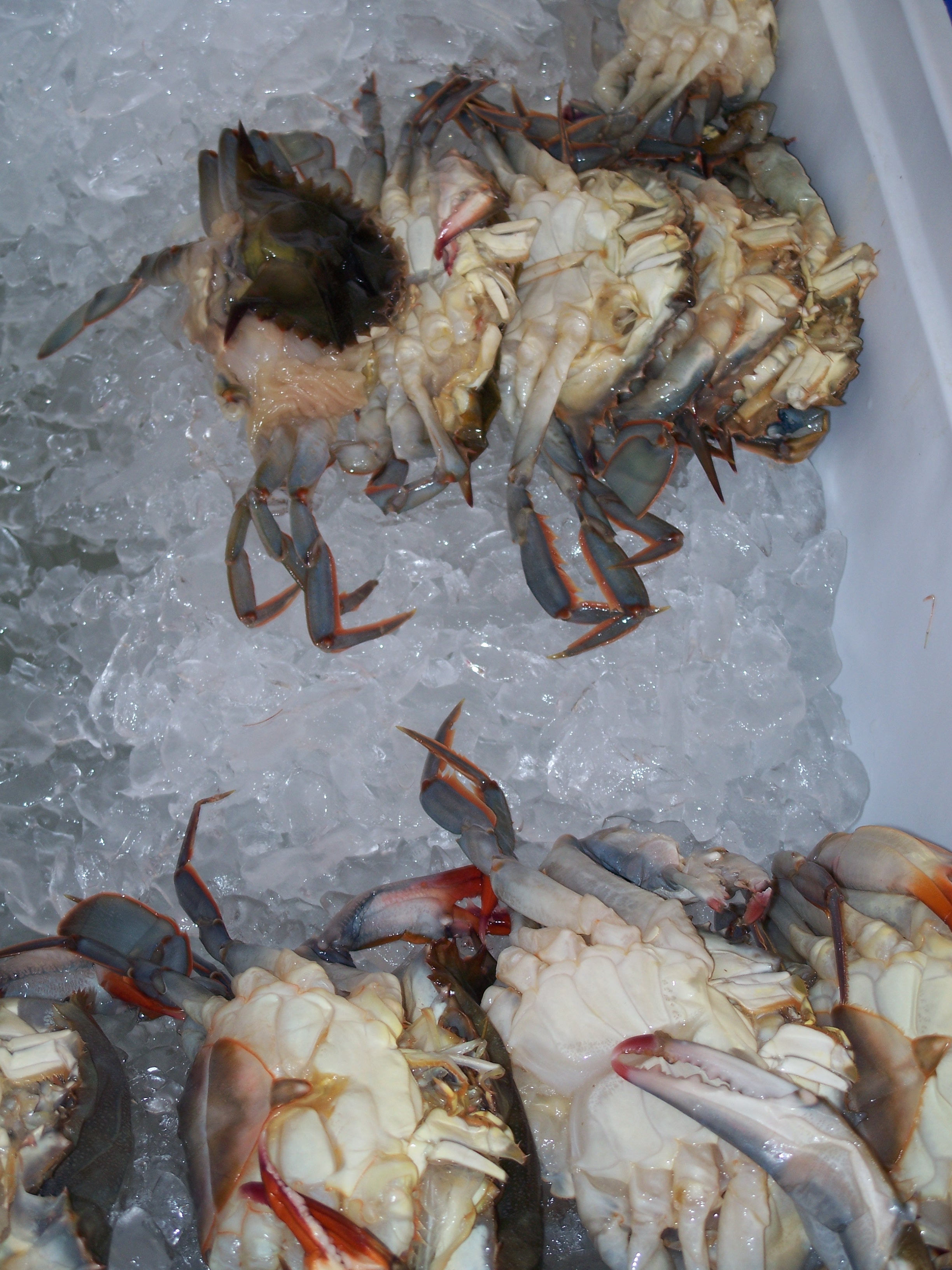
9. Artificial banana flavoring ¶
Something very unexpected: the artificial banana flavouring tastes so different from the real banana flavour because it was built upon a variety that is now extinct. And its flavour was very close.
Remember how isoamyl acetate is the chemical compound primarily responsible for banana flavoring? Gros Michel contains more of that compound than the Cavendish. In fact, isoamyl acetate was one of the first chemical compounds used in artificial flavors that was confirmed to exist in the actual fruit as well.
So, when you’re biting into a piece of banana Laffy Taffy, you’re getting a taste of the bananas of the past. “That’s kind of why I think of these older, ‘cheap’ artificial flavors as ‘heirloom’ artificial flavors,” says Berenstein. “Because they’re the simpler formulas that have been less modified by time.”
So the artificial flavouring is our only way to taste the bananas from years ago.
10. Self-heating cans of soup ¶
During the Second world war Heinz created a self-heating soup can, but due to its design it would often explode.
The soup was ready in just four minutes because of a heating element which ran through the centre of the can. It was lit by a fuse.
The instructions told soldiers to use a lit cigarette for the job. The fuse smokes until it burns to the level of the heating element.
(image by thejournal.ie)
Apparently today there are certain companies making something similar, although they have powders that get hot when the water is added, and these are mostly used for hot tea, sake, or cup noodles in Japan.
Book of the week ¶
I was browsing around trying to find creative ways to use up persimmons, as eating them in the season makes me shudder from the amount of sugar in the fruit.
Most recipes throw away peels (I lactoferment them occasionally), and use the pulp to make a puree of sorts and then turn it into either savory sauces or sweet desserts.
I didn't find a better way (and most persimmons were eaten in the meantime), but during my research stumbled upon a lovely book about two chefs and two different perspectives (and hence recipes) on running two restaurants together.
From A Very Serious Cookbook: Contra Wildair by Alison Roman, Fabián von Hauske, and Jeremiah Stone:
Growing up, I heard every good Chinese chef had his most secret recipes locked away in his head, and with them a lifetime of experiences and knowledge taken to the grave. Chinese cooks do not just hand down recipes. So when we talked about which dishes to include in this book, the littleneck clams with XO sauce made me sweat a little. It wasn't the Montauk clams, which I'll gladly talk about. Or even the bitter almond milk. It was the XO sauce. The Chinese part. Everyone thought I was kidding when I said I wasn't going to give a recipe for it, but I wasn't and still might not, we'll see.
XO is a condiment made up of dried scallops and shrimp (prawns) that came out of the Hong Kong restaurant scene in the '80s. There isn't any actual Cognac in the sauce, but it's said the name refers more to "extra old" - that and the type of Cognac (XO) that all the Chinese chefs drank after work. My dad would make a remark about a restaurant being a good one if they are willing to put a huge dollop of XO sauce on the table for you.
It is mostly a collection of recipes, which is a shame, given how good the occasional anecdotes are, but it is also a sneak peek into a New York cuisine circa 2017, and the main thing I have learnt about New York's food scene is that whatever they eat becomes a trend in the rest of the world a few years later.
So brace yourself for oysters with lapsang souchong, just saying.
Thank you and see you in a week! ¶
If you have any questions, or want to suggest a link for the next newsletter, please drop me a message on Twitter or reply to this email.
Cheers! 🍸
